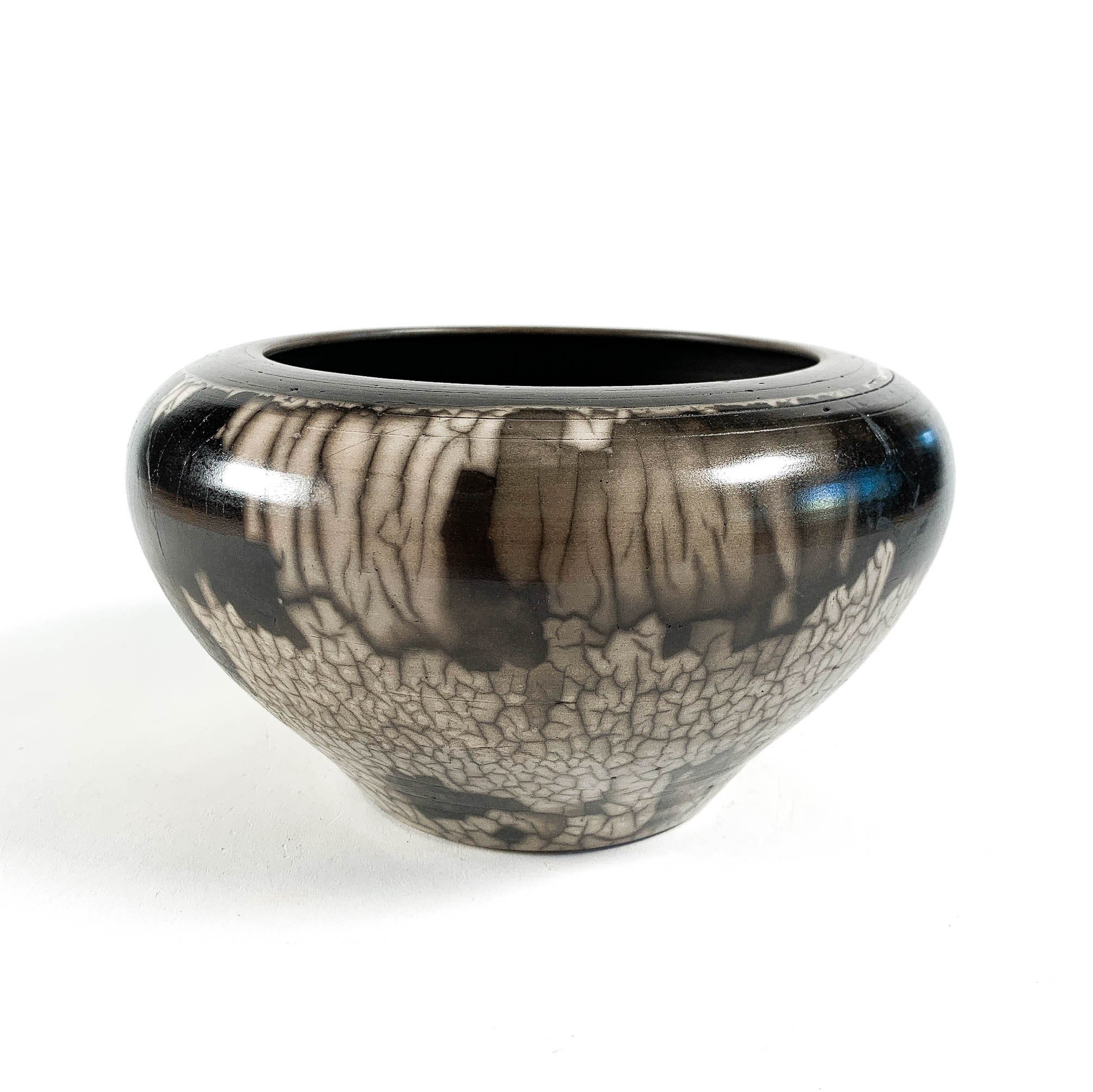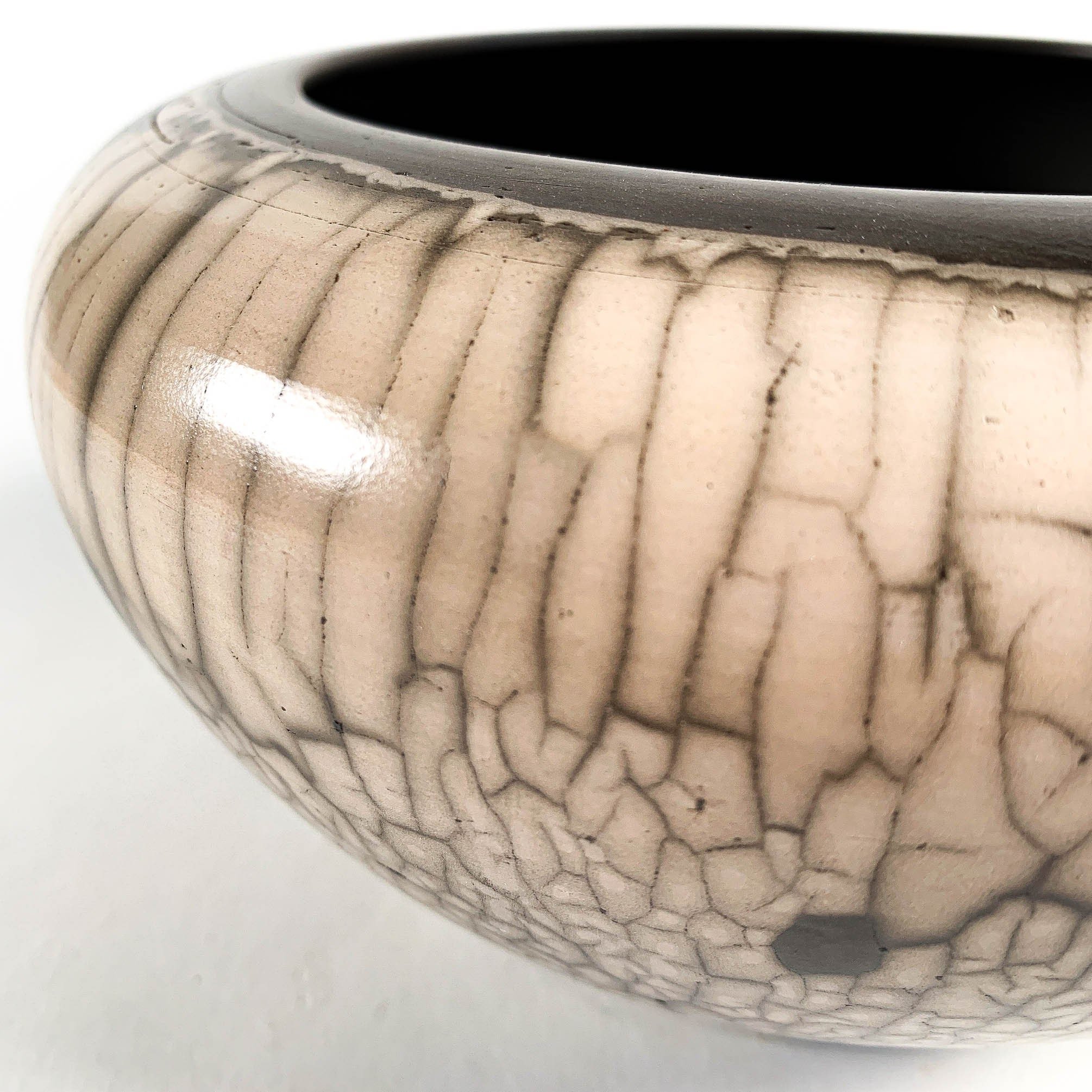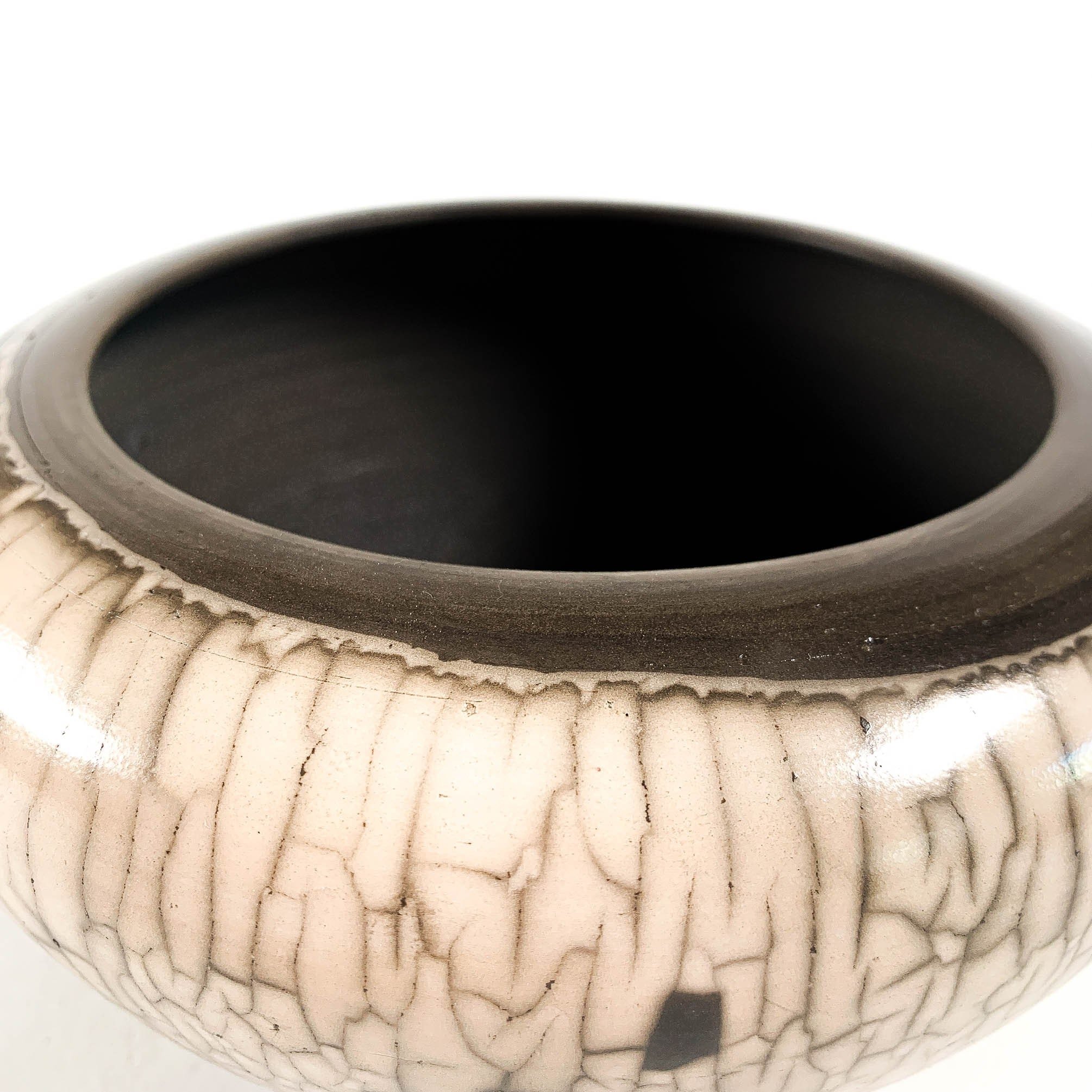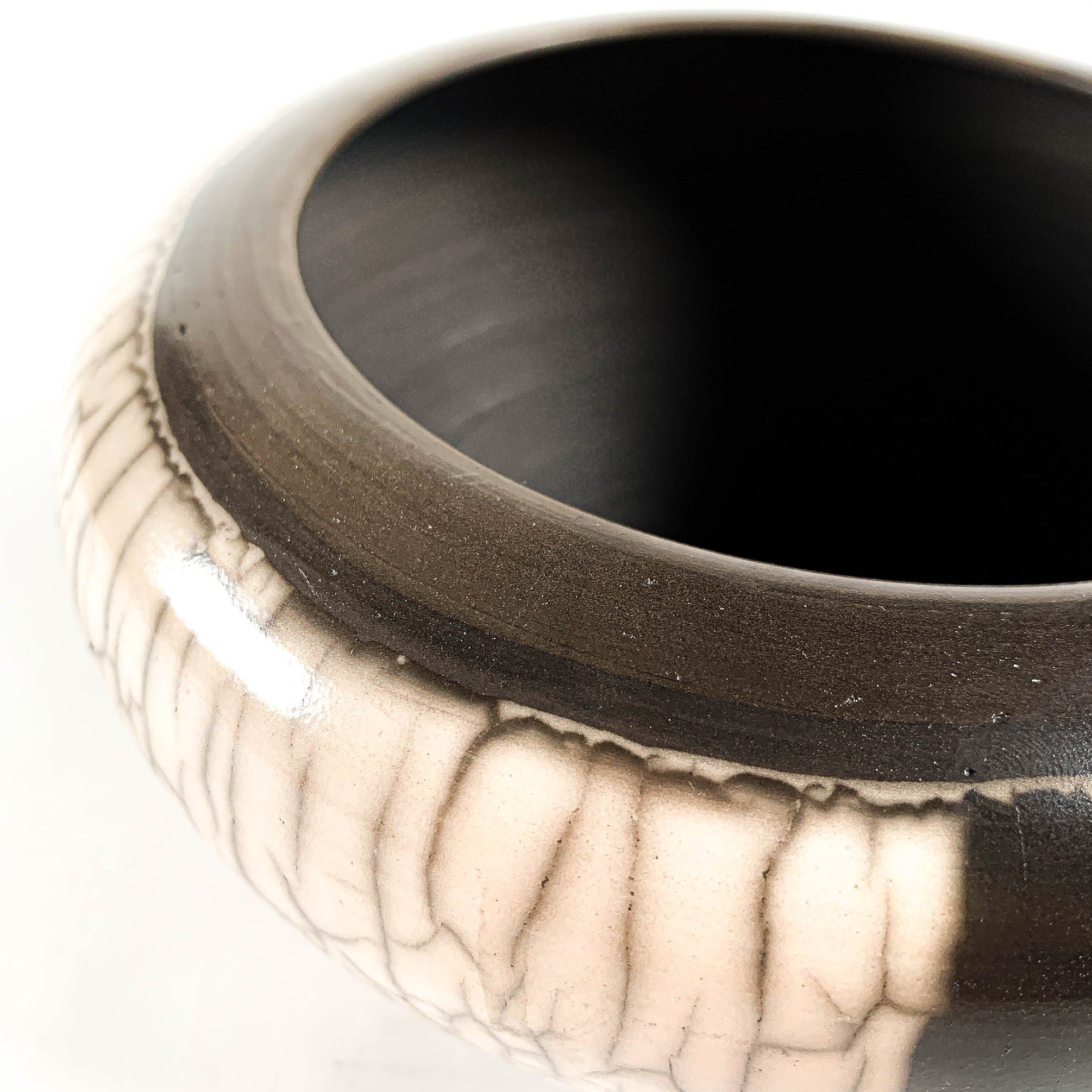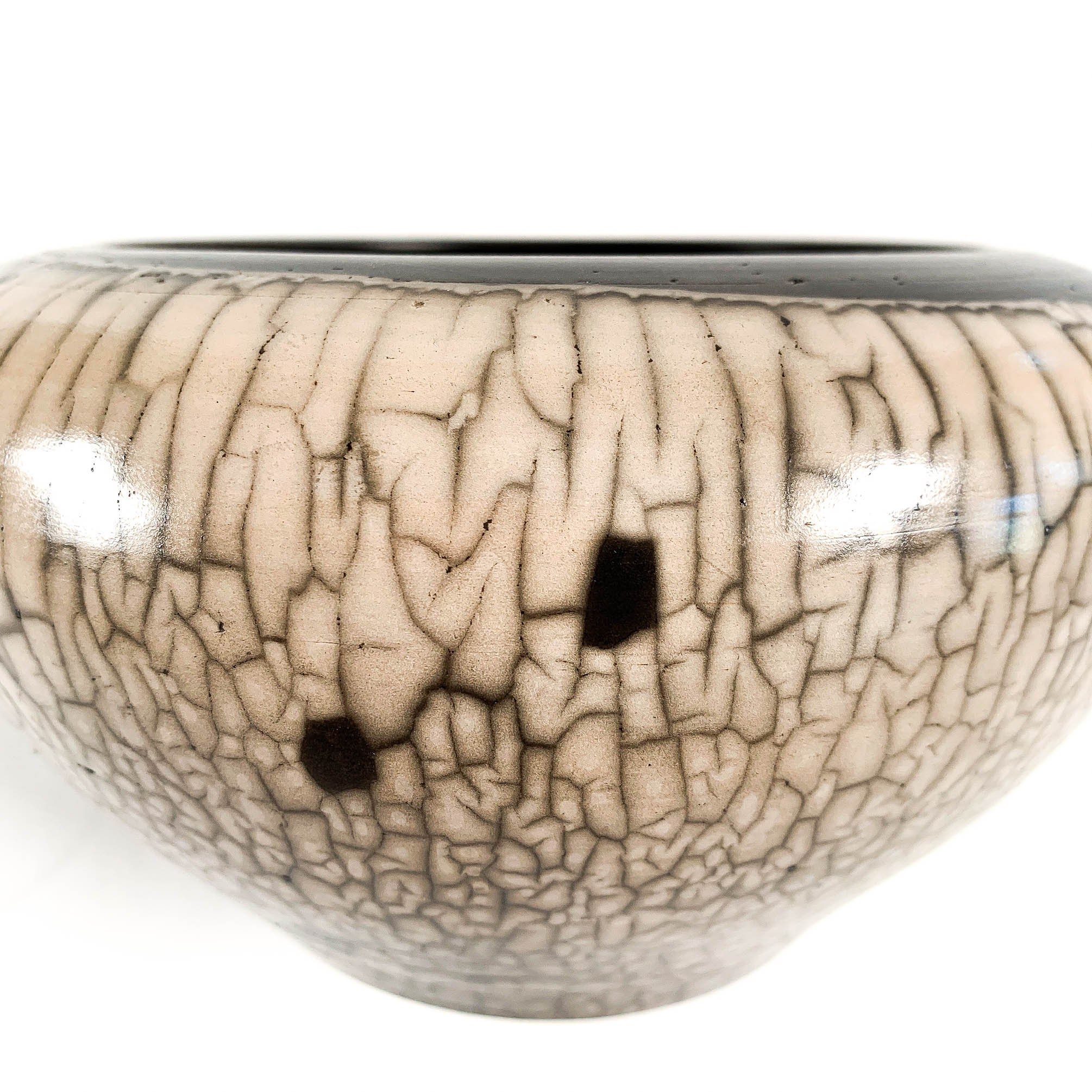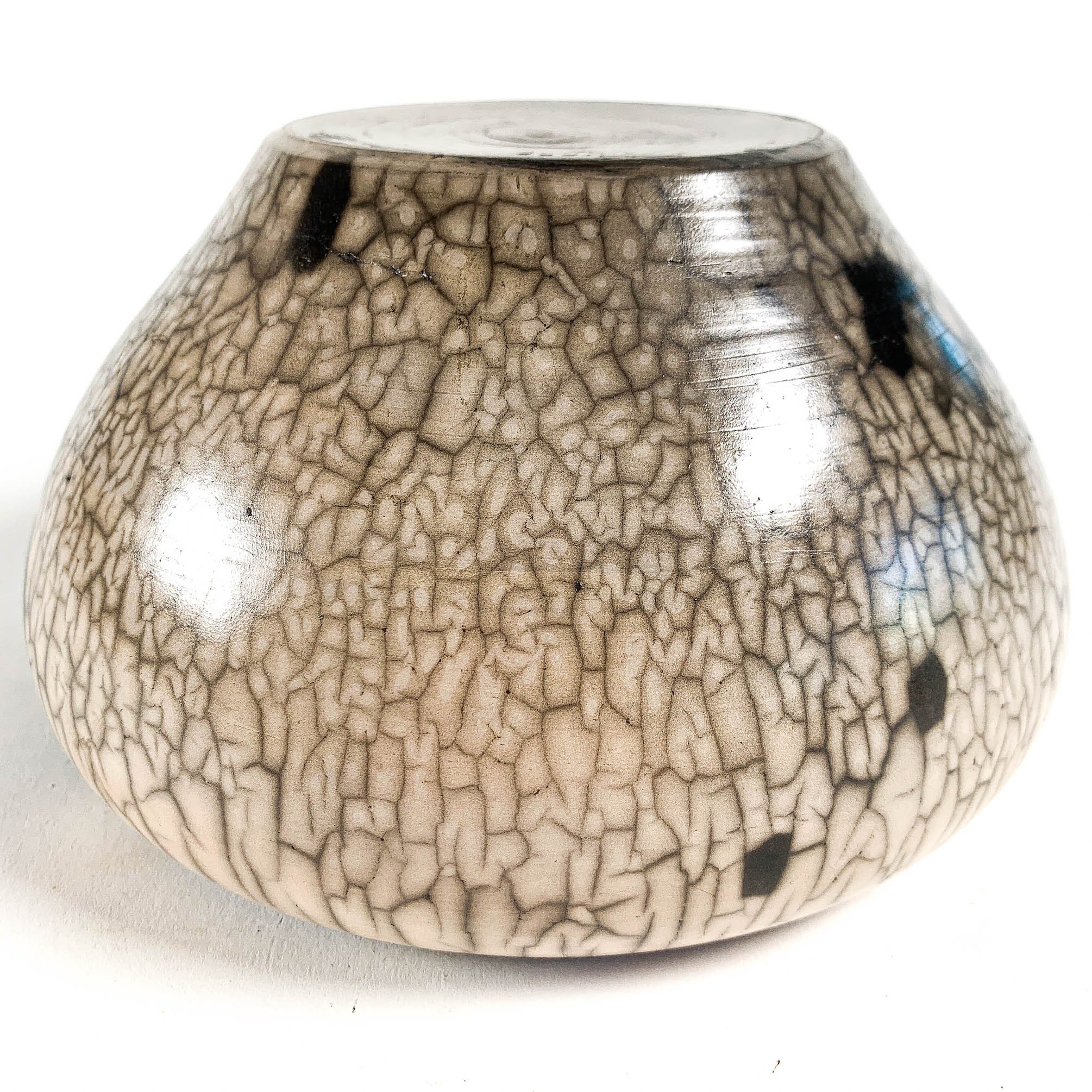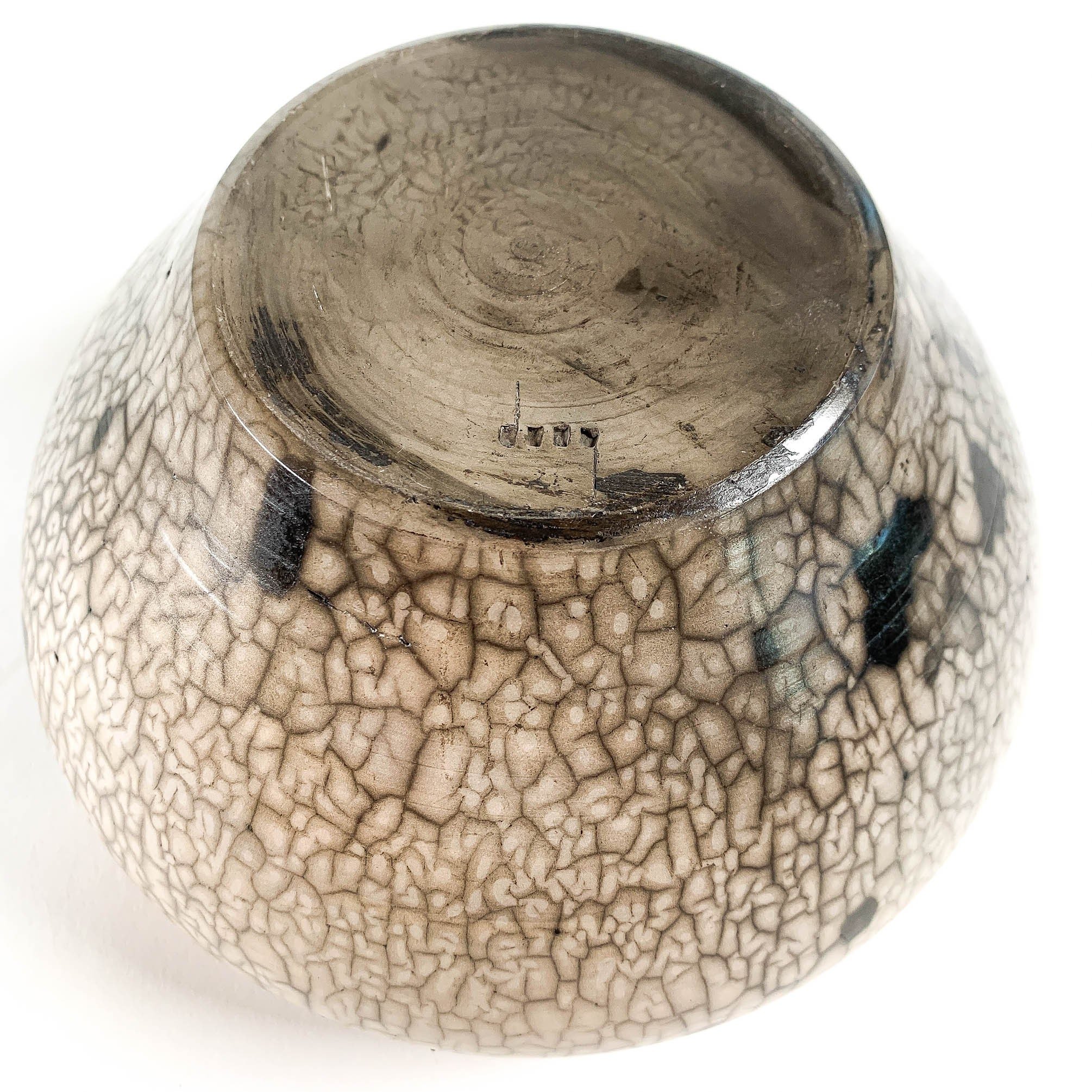Stout Moon Raku Vase (Second)
$175.00
Sold Out
This bold little vase is a product of the heat, flame and char of a wonderful firing technique called Naked Raku!
This piece is completely unique and is ornamented with a stunningly bright decorative contrast of its black and white surface. One of the distinguishing factors of this piece is how the contrast of black and white play along the widest outer edge of the pot. Typically with this process it is common to see a stark white or black area, but this piece boasts an interesting area that is somehow black and transparent at the same time! Effects like this are always a beautiful reminder of why Raku is such loved process.
Additionally, this piece is also very light weight and has a wonderful feel in the hand.
Please note: This piece is considered a second due to some internal cracking. As the Raku process can be a violent one for the pots to go through, it is common for cracks or breakages to occur during the process. In general, one way to test if a piece of pottery has any cracks is to thump it and listen to how it resonates. If it resonates and sustains a ringing sound that means it does not have any cracks. This piece, when thumped, does not resonate, meaning that there is an internal crack somewhere. As Raku pieces are inherently decorative and not functional the internal crack poses no issues to its functionality. All that it means is it should be cared for a little more gently. The price has been reduced accordingly.
This piece is $175 and ships for free.
Naked Raku is a specific type of Raku firing in which a specialized slip is added to the piece just before it goes into the Raku kiln to be fired. As the slip begins to dry on the piece, it slightly shrinks and begins to naturally form cracks around the pottery. As the firing continues the cracked slip (hopefully) remains on the piece of pottery and when the peak temperature is reached (1450 degrees) the piece is very carefully removed from the kiln and placed into a reduction chamber. The transition of the piece from kiln to can is very delicate and important because the slip that was applied to the pottery is now ceramic-like and it can completely fall off of the pottery if jostled, touched or bumped into.
The reduction chamber that I use is just a trashcan with paper inside to ignite. Once the piece is in the reduction chamber and the paper begins to burn around the pot, it is creating carbon from the fire and smoke. Once well aflame I cover the can creating a reduction atmosphere, which means that no more oxygen is fueling the fire. In that quick environmental shift inside of the can, the fire seeks out any oxygen it can to keep it alive, yielding a vacuum-like atmosphere inside of the chamber. In this timeframe, any areas of the pot that were exposed— meaning any parts of the vase that there was not slip still adhered to and the natural clay body exposed— will turn completely black. In turn, any areas of that pot that had the slip still attached and had the cracking formation will also be adorned with a delicate design. The smoke goes in between the cracked pieces of slip and sinters into the clay, creating irreplicable patterns. Any areas covered by the slip remain completely white.
The next step of taking the pieces out of the kiln is quite satisfying as the slip gets to be removed and the final result begins to come into light! Removing the slip carefully, the pieces fall off of the pot sounding like tiny bits of ceramic/glass, tinking on the ground.
The final result of this process yields these incredible black and white finishes with intricate fractal patterning. Their surfaces are what is refereed to as a “sintered surface,” as apposed to a glaze. This means that the patterning is sintered, or burned, into the body of the pot itself. To bolster, emphasize and protect this wonderful design first I clean off the pots of all char and other unwanted firing relics and then apply a spray fixative. The fixative helps to insure that the black designs do not smear and remain intact on the pots. This is the first moment in which the black areas become darker and the white areas more bright. After this step I apply a wax and buff the pieces to bring out a further shine and also seal the pots a bit more, rendering their porosity much lower. And lastly I apply an acrylic UV protectant on the pots to protect them from fading over time.
Please note: Although I have applied a UV protectant coating on this piece, Raku pieces in general can be subject to fading if left in direct sunlight for extended periods of time. Though the coating will protect it to some degree, I highly advise finding a place for each piece in your home that has lower light threshold to ensure that the piece’s brilliance remains bold for years and years to come!
Naked Raku pieces are decorative and not functional for holding water. They can of course be used with dried plants but they are not water-tight.
As the environment is a large portion of the inspiration in my work, it is also on the forefront of my mind when considering shipping, which is why I make sure to use 100% recyclable materials. The packing tape is water activated, which creates a permanent seal to the box and helps reduce the amount of tape I use (and since the tape is 100% recyclable/biodegradable, it can be recycled with the box itself!). I use a thermal printer to print out my shipping labels (using no ink cartridges) and the backing of the labels are also recyclable. Lastly, to ensure that packages arrive to you safely I take great care in packing up my items to send. I use paper-packing materials are all 100% recyclable and I reuse post-consumer packing materials whenever I can!
Along with the wonderfully grounding feeling of experiencing a handmade object, I feel that it is also my responsibility as an artist and a maker to provide you with piece of mind into the steps I've taken to reduce the amount of waste produced from my shop. The earth provides us with marvel and beauty and I believe that through measures such as these, we get a little bit closer to experiencing our own personal fifth season.
Thank you very much for having a look at this unique piece!
If you have any questions please feel free to reach out to me.
Warmly,
Doug
This piece is completely unique and is ornamented with a stunningly bright decorative contrast of its black and white surface. One of the distinguishing factors of this piece is how the contrast of black and white play along the widest outer edge of the pot. Typically with this process it is common to see a stark white or black area, but this piece boasts an interesting area that is somehow black and transparent at the same time! Effects like this are always a beautiful reminder of why Raku is such loved process.
Additionally, this piece is also very light weight and has a wonderful feel in the hand.
Please note: This piece is considered a second due to some internal cracking. As the Raku process can be a violent one for the pots to go through, it is common for cracks or breakages to occur during the process. In general, one way to test if a piece of pottery has any cracks is to thump it and listen to how it resonates. If it resonates and sustains a ringing sound that means it does not have any cracks. This piece, when thumped, does not resonate, meaning that there is an internal crack somewhere. As Raku pieces are inherently decorative and not functional the internal crack poses no issues to its functionality. All that it means is it should be cared for a little more gently. The price has been reduced accordingly.
This piece is $175 and ships for free.
Naked Raku is a specific type of Raku firing in which a specialized slip is added to the piece just before it goes into the Raku kiln to be fired. As the slip begins to dry on the piece, it slightly shrinks and begins to naturally form cracks around the pottery. As the firing continues the cracked slip (hopefully) remains on the piece of pottery and when the peak temperature is reached (1450 degrees) the piece is very carefully removed from the kiln and placed into a reduction chamber. The transition of the piece from kiln to can is very delicate and important because the slip that was applied to the pottery is now ceramic-like and it can completely fall off of the pottery if jostled, touched or bumped into.
The reduction chamber that I use is just a trashcan with paper inside to ignite. Once the piece is in the reduction chamber and the paper begins to burn around the pot, it is creating carbon from the fire and smoke. Once well aflame I cover the can creating a reduction atmosphere, which means that no more oxygen is fueling the fire. In that quick environmental shift inside of the can, the fire seeks out any oxygen it can to keep it alive, yielding a vacuum-like atmosphere inside of the chamber. In this timeframe, any areas of the pot that were exposed— meaning any parts of the vase that there was not slip still adhered to and the natural clay body exposed— will turn completely black. In turn, any areas of that pot that had the slip still attached and had the cracking formation will also be adorned with a delicate design. The smoke goes in between the cracked pieces of slip and sinters into the clay, creating irreplicable patterns. Any areas covered by the slip remain completely white.
The next step of taking the pieces out of the kiln is quite satisfying as the slip gets to be removed and the final result begins to come into light! Removing the slip carefully, the pieces fall off of the pot sounding like tiny bits of ceramic/glass, tinking on the ground.
The final result of this process yields these incredible black and white finishes with intricate fractal patterning. Their surfaces are what is refereed to as a “sintered surface,” as apposed to a glaze. This means that the patterning is sintered, or burned, into the body of the pot itself. To bolster, emphasize and protect this wonderful design first I clean off the pots of all char and other unwanted firing relics and then apply a spray fixative. The fixative helps to insure that the black designs do not smear and remain intact on the pots. This is the first moment in which the black areas become darker and the white areas more bright. After this step I apply a wax and buff the pieces to bring out a further shine and also seal the pots a bit more, rendering their porosity much lower. And lastly I apply an acrylic UV protectant on the pots to protect them from fading over time.
Please note: Although I have applied a UV protectant coating on this piece, Raku pieces in general can be subject to fading if left in direct sunlight for extended periods of time. Though the coating will protect it to some degree, I highly advise finding a place for each piece in your home that has lower light threshold to ensure that the piece’s brilliance remains bold for years and years to come!
Naked Raku pieces are decorative and not functional for holding water. They can of course be used with dried plants but they are not water-tight.
As the environment is a large portion of the inspiration in my work, it is also on the forefront of my mind when considering shipping, which is why I make sure to use 100% recyclable materials. The packing tape is water activated, which creates a permanent seal to the box and helps reduce the amount of tape I use (and since the tape is 100% recyclable/biodegradable, it can be recycled with the box itself!). I use a thermal printer to print out my shipping labels (using no ink cartridges) and the backing of the labels are also recyclable. Lastly, to ensure that packages arrive to you safely I take great care in packing up my items to send. I use paper-packing materials are all 100% recyclable and I reuse post-consumer packing materials whenever I can!
Along with the wonderfully grounding feeling of experiencing a handmade object, I feel that it is also my responsibility as an artist and a maker to provide you with piece of mind into the steps I've taken to reduce the amount of waste produced from my shop. The earth provides us with marvel and beauty and I believe that through measures such as these, we get a little bit closer to experiencing our own personal fifth season.
Thank you very much for having a look at this unique piece!
If you have any questions please feel free to reach out to me.
Warmly,
Doug
This bold little vase is a product of the heat, flame and char of a wonderful firing technique called Naked Raku!
This piece is completely unique and is ornamented with a stunningly bright decorative contrast of its black and white surface. One of the distinguishing factors of this piece is how the contrast of black and white play along the widest outer edge of the pot. Typically with this process it is common to see a stark white or black area, but this piece boasts an interesting area that is somehow black and transparent at the same time! Effects like this are always a beautiful reminder of why Raku is such loved process.
Additionally, this piece is also very light weight and has a wonderful feel in the hand.
Please note: This piece is considered a second due to some internal cracking. As the Raku process can be a violent one for the pots to go through, it is common for cracks or breakages to occur during the process. In general, one way to test if a piece of pottery has any cracks is to thump it and listen to how it resonates. If it resonates and sustains a ringing sound that means it does not have any cracks. This piece, when thumped, does not resonate, meaning that there is an internal crack somewhere. As Raku pieces are inherently decorative and not functional the internal crack poses no issues to its functionality. All that it means is it should be cared for a little more gently. The price has been reduced accordingly.
This piece is $175 and ships for free.
Naked Raku is a specific type of Raku firing in which a specialized slip is added to the piece just before it goes into the Raku kiln to be fired. As the slip begins to dry on the piece, it slightly shrinks and begins to naturally form cracks around the pottery. As the firing continues the cracked slip (hopefully) remains on the piece of pottery and when the peak temperature is reached (1450 degrees) the piece is very carefully removed from the kiln and placed into a reduction chamber. The transition of the piece from kiln to can is very delicate and important because the slip that was applied to the pottery is now ceramic-like and it can completely fall off of the pottery if jostled, touched or bumped into.
The reduction chamber that I use is just a trashcan with paper inside to ignite. Once the piece is in the reduction chamber and the paper begins to burn around the pot, it is creating carbon from the fire and smoke. Once well aflame I cover the can creating a reduction atmosphere, which means that no more oxygen is fueling the fire. In that quick environmental shift inside of the can, the fire seeks out any oxygen it can to keep it alive, yielding a vacuum-like atmosphere inside of the chamber. In this timeframe, any areas of the pot that were exposed— meaning any parts of the vase that there was not slip still adhered to and the natural clay body exposed— will turn completely black. In turn, any areas of that pot that had the slip still attached and had the cracking formation will also be adorned with a delicate design. The smoke goes in between the cracked pieces of slip and sinters into the clay, creating irreplicable patterns. Any areas covered by the slip remain completely white.
The next step of taking the pieces out of the kiln is quite satisfying as the slip gets to be removed and the final result begins to come into light! Removing the slip carefully, the pieces fall off of the pot sounding like tiny bits of ceramic/glass, tinking on the ground.
The final result of this process yields these incredible black and white finishes with intricate fractal patterning. Their surfaces are what is refereed to as a “sintered surface,” as apposed to a glaze. This means that the patterning is sintered, or burned, into the body of the pot itself. To bolster, emphasize and protect this wonderful design first I clean off the pots of all char and other unwanted firing relics and then apply a spray fixative. The fixative helps to insure that the black designs do not smear and remain intact on the pots. This is the first moment in which the black areas become darker and the white areas more bright. After this step I apply a wax and buff the pieces to bring out a further shine and also seal the pots a bit more, rendering their porosity much lower. And lastly I apply an acrylic UV protectant on the pots to protect them from fading over time.
Please note: Although I have applied a UV protectant coating on this piece, Raku pieces in general can be subject to fading if left in direct sunlight for extended periods of time. Though the coating will protect it to some degree, I highly advise finding a place for each piece in your home that has lower light threshold to ensure that the piece’s brilliance remains bold for years and years to come!
Naked Raku pieces are decorative and not functional for holding water. They can of course be used with dried plants but they are not water-tight.
As the environment is a large portion of the inspiration in my work, it is also on the forefront of my mind when considering shipping, which is why I make sure to use 100% recyclable materials. The packing tape is water activated, which creates a permanent seal to the box and helps reduce the amount of tape I use (and since the tape is 100% recyclable/biodegradable, it can be recycled with the box itself!). I use a thermal printer to print out my shipping labels (using no ink cartridges) and the backing of the labels are also recyclable. Lastly, to ensure that packages arrive to you safely I take great care in packing up my items to send. I use paper-packing materials are all 100% recyclable and I reuse post-consumer packing materials whenever I can!
Along with the wonderfully grounding feeling of experiencing a handmade object, I feel that it is also my responsibility as an artist and a maker to provide you with piece of mind into the steps I've taken to reduce the amount of waste produced from my shop. The earth provides us with marvel and beauty and I believe that through measures such as these, we get a little bit closer to experiencing our own personal fifth season.
Thank you very much for having a look at this unique piece!
If you have any questions please feel free to reach out to me.
Warmly,
Doug
This piece is completely unique and is ornamented with a stunningly bright decorative contrast of its black and white surface. One of the distinguishing factors of this piece is how the contrast of black and white play along the widest outer edge of the pot. Typically with this process it is common to see a stark white or black area, but this piece boasts an interesting area that is somehow black and transparent at the same time! Effects like this are always a beautiful reminder of why Raku is such loved process.
Additionally, this piece is also very light weight and has a wonderful feel in the hand.
Please note: This piece is considered a second due to some internal cracking. As the Raku process can be a violent one for the pots to go through, it is common for cracks or breakages to occur during the process. In general, one way to test if a piece of pottery has any cracks is to thump it and listen to how it resonates. If it resonates and sustains a ringing sound that means it does not have any cracks. This piece, when thumped, does not resonate, meaning that there is an internal crack somewhere. As Raku pieces are inherently decorative and not functional the internal crack poses no issues to its functionality. All that it means is it should be cared for a little more gently. The price has been reduced accordingly.
This piece is $175 and ships for free.
Naked Raku is a specific type of Raku firing in which a specialized slip is added to the piece just before it goes into the Raku kiln to be fired. As the slip begins to dry on the piece, it slightly shrinks and begins to naturally form cracks around the pottery. As the firing continues the cracked slip (hopefully) remains on the piece of pottery and when the peak temperature is reached (1450 degrees) the piece is very carefully removed from the kiln and placed into a reduction chamber. The transition of the piece from kiln to can is very delicate and important because the slip that was applied to the pottery is now ceramic-like and it can completely fall off of the pottery if jostled, touched or bumped into.
The reduction chamber that I use is just a trashcan with paper inside to ignite. Once the piece is in the reduction chamber and the paper begins to burn around the pot, it is creating carbon from the fire and smoke. Once well aflame I cover the can creating a reduction atmosphere, which means that no more oxygen is fueling the fire. In that quick environmental shift inside of the can, the fire seeks out any oxygen it can to keep it alive, yielding a vacuum-like atmosphere inside of the chamber. In this timeframe, any areas of the pot that were exposed— meaning any parts of the vase that there was not slip still adhered to and the natural clay body exposed— will turn completely black. In turn, any areas of that pot that had the slip still attached and had the cracking formation will also be adorned with a delicate design. The smoke goes in between the cracked pieces of slip and sinters into the clay, creating irreplicable patterns. Any areas covered by the slip remain completely white.
The next step of taking the pieces out of the kiln is quite satisfying as the slip gets to be removed and the final result begins to come into light! Removing the slip carefully, the pieces fall off of the pot sounding like tiny bits of ceramic/glass, tinking on the ground.
The final result of this process yields these incredible black and white finishes with intricate fractal patterning. Their surfaces are what is refereed to as a “sintered surface,” as apposed to a glaze. This means that the patterning is sintered, or burned, into the body of the pot itself. To bolster, emphasize and protect this wonderful design first I clean off the pots of all char and other unwanted firing relics and then apply a spray fixative. The fixative helps to insure that the black designs do not smear and remain intact on the pots. This is the first moment in which the black areas become darker and the white areas more bright. After this step I apply a wax and buff the pieces to bring out a further shine and also seal the pots a bit more, rendering their porosity much lower. And lastly I apply an acrylic UV protectant on the pots to protect them from fading over time.
Please note: Although I have applied a UV protectant coating on this piece, Raku pieces in general can be subject to fading if left in direct sunlight for extended periods of time. Though the coating will protect it to some degree, I highly advise finding a place for each piece in your home that has lower light threshold to ensure that the piece’s brilliance remains bold for years and years to come!
Naked Raku pieces are decorative and not functional for holding water. They can of course be used with dried plants but they are not water-tight.
As the environment is a large portion of the inspiration in my work, it is also on the forefront of my mind when considering shipping, which is why I make sure to use 100% recyclable materials. The packing tape is water activated, which creates a permanent seal to the box and helps reduce the amount of tape I use (and since the tape is 100% recyclable/biodegradable, it can be recycled with the box itself!). I use a thermal printer to print out my shipping labels (using no ink cartridges) and the backing of the labels are also recyclable. Lastly, to ensure that packages arrive to you safely I take great care in packing up my items to send. I use paper-packing materials are all 100% recyclable and I reuse post-consumer packing materials whenever I can!
Along with the wonderfully grounding feeling of experiencing a handmade object, I feel that it is also my responsibility as an artist and a maker to provide you with piece of mind into the steps I've taken to reduce the amount of waste produced from my shop. The earth provides us with marvel and beauty and I believe that through measures such as these, we get a little bit closer to experiencing our own personal fifth season.
Thank you very much for having a look at this unique piece!
If you have any questions please feel free to reach out to me.
Warmly,
Doug
This bold little vase is a product of the heat, flame and char of a wonderful firing technique called Naked Raku!
This piece is completely unique and is ornamented with a stunningly bright decorative contrast of its black and white surface. One of the distinguishing factors of this piece is how the contrast of black and white play along the widest outer edge of the pot. Typically with this process it is common to see a stark white or black area, but this piece boasts an interesting area that is somehow black and transparent at the same time! Effects like this are always a beautiful reminder of why Raku is such loved process.
Additionally, this piece is also very light weight and has a wonderful feel in the hand.
Please note: This piece is considered a second due to some internal cracking. As the Raku process can be a violent one for the pots to go through, it is common for cracks or breakages to occur during the process. In general, one way to test if a piece of pottery has any cracks is to thump it and listen to how it resonates. If it resonates and sustains a ringing sound that means it does not have any cracks. This piece, when thumped, does not resonate, meaning that there is an internal crack somewhere. As Raku pieces are inherently decorative and not functional the internal crack poses no issues to its functionality. All that it means is it should be cared for a little more gently. The price has been reduced accordingly.
This piece is $175 and ships for free.
Naked Raku is a specific type of Raku firing in which a specialized slip is added to the piece just before it goes into the Raku kiln to be fired. As the slip begins to dry on the piece, it slightly shrinks and begins to naturally form cracks around the pottery. As the firing continues the cracked slip (hopefully) remains on the piece of pottery and when the peak temperature is reached (1450 degrees) the piece is very carefully removed from the kiln and placed into a reduction chamber. The transition of the piece from kiln to can is very delicate and important because the slip that was applied to the pottery is now ceramic-like and it can completely fall off of the pottery if jostled, touched or bumped into.
The reduction chamber that I use is just a trashcan with paper inside to ignite. Once the piece is in the reduction chamber and the paper begins to burn around the pot, it is creating carbon from the fire and smoke. Once well aflame I cover the can creating a reduction atmosphere, which means that no more oxygen is fueling the fire. In that quick environmental shift inside of the can, the fire seeks out any oxygen it can to keep it alive, yielding a vacuum-like atmosphere inside of the chamber. In this timeframe, any areas of the pot that were exposed— meaning any parts of the vase that there was not slip still adhered to and the natural clay body exposed— will turn completely black. In turn, any areas of that pot that had the slip still attached and had the cracking formation will also be adorned with a delicate design. The smoke goes in between the cracked pieces of slip and sinters into the clay, creating irreplicable patterns. Any areas covered by the slip remain completely white.
The next step of taking the pieces out of the kiln is quite satisfying as the slip gets to be removed and the final result begins to come into light! Removing the slip carefully, the pieces fall off of the pot sounding like tiny bits of ceramic/glass, tinking on the ground.
The final result of this process yields these incredible black and white finishes with intricate fractal patterning. Their surfaces are what is refereed to as a “sintered surface,” as apposed to a glaze. This means that the patterning is sintered, or burned, into the body of the pot itself. To bolster, emphasize and protect this wonderful design first I clean off the pots of all char and other unwanted firing relics and then apply a spray fixative. The fixative helps to insure that the black designs do not smear and remain intact on the pots. This is the first moment in which the black areas become darker and the white areas more bright. After this step I apply a wax and buff the pieces to bring out a further shine and also seal the pots a bit more, rendering their porosity much lower. And lastly I apply an acrylic UV protectant on the pots to protect them from fading over time.
Please note: Although I have applied a UV protectant coating on this piece, Raku pieces in general can be subject to fading if left in direct sunlight for extended periods of time. Though the coating will protect it to some degree, I highly advise finding a place for each piece in your home that has lower light threshold to ensure that the piece’s brilliance remains bold for years and years to come!
Naked Raku pieces are decorative and not functional for holding water. They can of course be used with dried plants but they are not water-tight.
As the environment is a large portion of the inspiration in my work, it is also on the forefront of my mind when considering shipping, which is why I make sure to use 100% recyclable materials. The packing tape is water activated, which creates a permanent seal to the box and helps reduce the amount of tape I use (and since the tape is 100% recyclable/biodegradable, it can be recycled with the box itself!). I use a thermal printer to print out my shipping labels (using no ink cartridges) and the backing of the labels are also recyclable. Lastly, to ensure that packages arrive to you safely I take great care in packing up my items to send. I use paper-packing materials are all 100% recyclable and I reuse post-consumer packing materials whenever I can!
Along with the wonderfully grounding feeling of experiencing a handmade object, I feel that it is also my responsibility as an artist and a maker to provide you with piece of mind into the steps I've taken to reduce the amount of waste produced from my shop. The earth provides us with marvel and beauty and I believe that through measures such as these, we get a little bit closer to experiencing our own personal fifth season.
Thank you very much for having a look at this unique piece!
If you have any questions please feel free to reach out to me.
Warmly,
Doug
This piece is completely unique and is ornamented with a stunningly bright decorative contrast of its black and white surface. One of the distinguishing factors of this piece is how the contrast of black and white play along the widest outer edge of the pot. Typically with this process it is common to see a stark white or black area, but this piece boasts an interesting area that is somehow black and transparent at the same time! Effects like this are always a beautiful reminder of why Raku is such loved process.
Additionally, this piece is also very light weight and has a wonderful feel in the hand.
Please note: This piece is considered a second due to some internal cracking. As the Raku process can be a violent one for the pots to go through, it is common for cracks or breakages to occur during the process. In general, one way to test if a piece of pottery has any cracks is to thump it and listen to how it resonates. If it resonates and sustains a ringing sound that means it does not have any cracks. This piece, when thumped, does not resonate, meaning that there is an internal crack somewhere. As Raku pieces are inherently decorative and not functional the internal crack poses no issues to its functionality. All that it means is it should be cared for a little more gently. The price has been reduced accordingly.
This piece is $175 and ships for free.
Naked Raku is a specific type of Raku firing in which a specialized slip is added to the piece just before it goes into the Raku kiln to be fired. As the slip begins to dry on the piece, it slightly shrinks and begins to naturally form cracks around the pottery. As the firing continues the cracked slip (hopefully) remains on the piece of pottery and when the peak temperature is reached (1450 degrees) the piece is very carefully removed from the kiln and placed into a reduction chamber. The transition of the piece from kiln to can is very delicate and important because the slip that was applied to the pottery is now ceramic-like and it can completely fall off of the pottery if jostled, touched or bumped into.
The reduction chamber that I use is just a trashcan with paper inside to ignite. Once the piece is in the reduction chamber and the paper begins to burn around the pot, it is creating carbon from the fire and smoke. Once well aflame I cover the can creating a reduction atmosphere, which means that no more oxygen is fueling the fire. In that quick environmental shift inside of the can, the fire seeks out any oxygen it can to keep it alive, yielding a vacuum-like atmosphere inside of the chamber. In this timeframe, any areas of the pot that were exposed— meaning any parts of the vase that there was not slip still adhered to and the natural clay body exposed— will turn completely black. In turn, any areas of that pot that had the slip still attached and had the cracking formation will also be adorned with a delicate design. The smoke goes in between the cracked pieces of slip and sinters into the clay, creating irreplicable patterns. Any areas covered by the slip remain completely white.
The next step of taking the pieces out of the kiln is quite satisfying as the slip gets to be removed and the final result begins to come into light! Removing the slip carefully, the pieces fall off of the pot sounding like tiny bits of ceramic/glass, tinking on the ground.
The final result of this process yields these incredible black and white finishes with intricate fractal patterning. Their surfaces are what is refereed to as a “sintered surface,” as apposed to a glaze. This means that the patterning is sintered, or burned, into the body of the pot itself. To bolster, emphasize and protect this wonderful design first I clean off the pots of all char and other unwanted firing relics and then apply a spray fixative. The fixative helps to insure that the black designs do not smear and remain intact on the pots. This is the first moment in which the black areas become darker and the white areas more bright. After this step I apply a wax and buff the pieces to bring out a further shine and also seal the pots a bit more, rendering their porosity much lower. And lastly I apply an acrylic UV protectant on the pots to protect them from fading over time.
Please note: Although I have applied a UV protectant coating on this piece, Raku pieces in general can be subject to fading if left in direct sunlight for extended periods of time. Though the coating will protect it to some degree, I highly advise finding a place for each piece in your home that has lower light threshold to ensure that the piece’s brilliance remains bold for years and years to come!
Naked Raku pieces are decorative and not functional for holding water. They can of course be used with dried plants but they are not water-tight.
As the environment is a large portion of the inspiration in my work, it is also on the forefront of my mind when considering shipping, which is why I make sure to use 100% recyclable materials. The packing tape is water activated, which creates a permanent seal to the box and helps reduce the amount of tape I use (and since the tape is 100% recyclable/biodegradable, it can be recycled with the box itself!). I use a thermal printer to print out my shipping labels (using no ink cartridges) and the backing of the labels are also recyclable. Lastly, to ensure that packages arrive to you safely I take great care in packing up my items to send. I use paper-packing materials are all 100% recyclable and I reuse post-consumer packing materials whenever I can!
Along with the wonderfully grounding feeling of experiencing a handmade object, I feel that it is also my responsibility as an artist and a maker to provide you with piece of mind into the steps I've taken to reduce the amount of waste produced from my shop. The earth provides us with marvel and beauty and I believe that through measures such as these, we get a little bit closer to experiencing our own personal fifth season.
Thank you very much for having a look at this unique piece!
If you have any questions please feel free to reach out to me.
Warmly,
Doug



